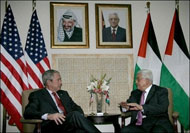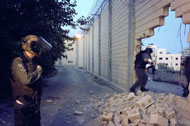When US President George W. Bush announced after Annapolis that he planned to make his first trip to the Middle East as President in January to push the peace process along, one could have predicted that a visit by the head of state of the world’s only superpower would dominate and monopolize the proceedings in the press that week, which is exactly what happened.
On January 7, the respective heads of the Israeli and Palestinian negotiating teams, Israeli Foreign Minister Tzipi Livni and former Palestinian Prime Minister Ahmed Qurei, met in an attempt to resolve some of the issues currently existing between the two sides. The major dispute centers around Jewish settlement expansion on occupied land near Jerusalem, especially the enlargement of the Har Homa / Jabal Abu Gheim settlement just days after Annapolis. However, by the close of the meeting, no agreement had been announced.
Feeling the pressure of the President’s imminent arrival on January 9 and with no tangible or significant progress in the six weeks since Annapolis, President Abbas and Prime Minister Olmert met on January 8 in Jerusalem in what commentators deemed a desperate attempt to reach an understanding on contended areas.
After their two hour meeting, it was announced that although there are differences over Jewish settlement construction near Jerusalem, they would strive to begin talks on “core” issues. No start date has been given but Palestinian negotiator Saeb Erekat stated that the talks would commence immediately, be discussed in secrecy between Tzipi Livni and Ahmed Qurei and would focus on settlements.
On the eve of the President’s visit, there were also huge protests from both sides on January 8. In the Hamas controlled Gaza Strip, Hamas proclaimed that Bush’s visit would only strengthen Israel and deepen the divisions among Palestinians. In addition, thousands of members of the Islamic Jihad took to the streets of Gaza City shouting “death to Israel and America”. A prominent leader of the group said that Palestinians “are sworn to God to fight…for the liberation of Palestine in its entirety…and we will uproot the enemy entity”. The people held signs with messages such as “we are killed by American weapons and we are besieged because of American decisions”.
In Jerusalem, thousands of Israeli nationalists formed a human chain around the Old City. Organizer Yehiel Leiter highlighted that the rally aimed “to show on the eve of President Bush’s arrival that Olmert does not represent this nation”. Other protesters held banners with “Bush, read your Bible. God gave Israel to the Jews” written on them.
The problems embedded in the peace process were epitomized in the hours before and after Bush’s arrival at noon on January 9. Regarding Israeli security, Katyusha rockets hit Israel from Lebanon and 13 Qassam rockets were launched from Gaza with one hitting the roof of a house in Sderot. On the Palestinian side, a further two illegal outposts were established in the Etzion bloc as well as near Ramallah and three Palestinians were killed by Israeli attacks on Gaza. Popular Resistance member, Amjad Abdel Dayem, was killed in Beit Lahiya in northern Gaza while civilians Khadra Wahdane and Mohammed al Kafarna were also killed in Beit Hanun, a town in northern Gaza.
President Bush stepped off Air Force One to a warm reception where he was welcomed by Israeli President Shimon Peres and Prime Minister Ehud Olmert. In the brief statements which followed his landing Bush declared “we see a new opportunity for peace here in the holy land and for freedom across the region”, concentrating specifically on the need for peace and democracy. Olmert commented on the closeness of their friendship, Bush reiterated his commitment to Israeli security and Peres emphasized the threat posed by Iran.
President Bush then continued onto Jerusalem where he held a one-on-one meeting with Olmert followed by a meeting with Israeli Defense Minister Ehud Barak and Foreign Minister Livni. In the press conference afterwards, President Bush supported his timeframe of the end of 2008 for a final agreement that would lead to the establishment of a state for Palestinians alongside the state of Israel as a homeland for the Jewish people. In order for this to happen, Bush announced that Israel must dismantle unauthorized settlement outposts and freeze construction in other West Bank settlements. In addition, President Bush underlined that rocket attacks on Israel must stop and Israel’s security must be ensured. Prime Minister Olmert said in response that “we are not going to build new settlements or expropriate land in the territories…Jerusalem, as far as we are concerned, is not in the same status."
A significant proportion of the press conference revolved around Iran. President Bush maintained that despite the US Military report which insinuated that Iran abandoned their nuclear ambitions following the Iraq War in 2003, “Iran was a threat, Iran is a threat and Iran will be a threat to world peace”.
On January 10, President Bush became only the second US President visit the occupied territories when he made the short journey to Ramallah, the de facto capital of the West Bank. The President had planned to take his Marine One helicopter but due to the thick fog, he was forced to travel in a 40 car envoy from the King David Hotel in Jerusalem to the Beit El checkpoint, on his way to see Palestinian President Mahmoud Abbas in the Muqata. The road from the hotel to the checkpoint was lined with Israeli soldiers but once the envoy passed the checkpoint onto land controlled by the PA, the President was accompanied by 4,000 Palestinian law enforcement officers, including snipers and spotters, parading the streets.
The area surrounding the compound was under a curfew from the early hours of January 10 until the President left at around two in the afternoon. Residents in the zone were confined to their houses and banned from entering the streets.
While President Bush met with President Abbas in the Muqata, around 200 demonstrators hit the streets in the center of Ramallah with the banners “Bush war criminal!” and “Bush out!” brandished on them. The protesters were expressing their deep skepticism over Bush’ visit, questioning his ability to apply the pressure required on Israel to bring about a Palestinian state by the end of the year. The Palestinian security forces used tear gas and batons to suppress the crowd, consisting mostly of older Palestinians, and even arrested the most vocal participants.
In both his press conference with Abbas and in his address back in Jerusalem, President Bush reiterated the prerequisites for a successful deal to emerge. “On the Israeli side, that includes ending settlement expansion and removing unauthorized outposts. On the Palestinian side that includes confronting terrorists and dismantling terrorist infrastructure”. However, the President did say that “there should be an end to the occupation that began in 1967”. Bush does not always refer to the situation as an “occupation” and his use of the word has caught the attention of commentators who attest that its use may imply proof of Bush’s increasingly hardened stance in pressuring Israel to abide by its obligations.
After meeting President Abbas in Ramallah, Bush traveled to Bethlehem to pray at the Church of the Nativity, the location believed to be the birthplace of Christ. Following his tour of the church Bush described how “for those of us who practise the Christian faith, there isn’t a more holy site than where our savior was born”.
On January 11, Bush continued on his pilgrimage to Galilee where Jesus is said to have delivered his Sermon on the Mount famously declaring “blessed are the peacemakers for they shall be called the children of God”. Previously, President Bush had paid his respects at Jerusalem’s Yad Vashem memorial which commemorates the six million Jews who died during the Holocaust.
The trip to Galilee signaled the end of Bush’s stay in the holy land but he expressed his wish to return to celebrate Israel’s 60th anniversary which occurs in May. The President left for Kuwait on January 11 which marks the beginning of his tour to the Arab states of Bahrain, United Arab Emirates, Saudi Arabia and Egypt where the President hopes to rally support for the Israeli/Palestinian peace process as well as address the rising regional influence of Iran.








